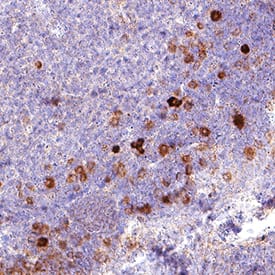Mouse CXCL10/IP-10/CRG-2 Antibody
R&D Systems, part of Bio-Techne | Catalog # MAB4661

Key Product Details
Species Reactivity
Mouse
Applications
Immunocytochemistry, Immunohistochemistry
Label
Unconjugated
Antibody Source
Monoclonal Rat IgG2A Clone # 1050502
Product Specifications
Immunogen
E. coli-derived mouse CXCL10/IP-10/CRG-2 protein
Ile22-Pro98
Accession # Q548V9
Ile22-Pro98
Accession # Q548V9
Specificity
Detects mouse CXCL10/IP-10/CRG-2 in direct and capture Elisas.
Clonality
Monoclonal
Host
Rat
Isotype
IgG2A
Scientific Data Images for Mouse CXCL10/IP-10/CRG-2 Antibody
Detection of CXCL10/IP-10/CRG-2 in mouse mIMCD3 cell line.
CXCL10/IP-10/CRG-2 was detected in immersion fixed mIMCD3 (positive) or C2C12 (negative) mouse cell line using Rat Anti-Mouse CXCL10/IP-10/CRG-2 Monoclonal Antibody (Catalog # MAB4661) at 3 µg/mL for 3 hours at room temperature. Cells were stained using the NorthernLights™ 557-conjugated Anti-Rat IgG Secondary Antibody (red; NL013) and counterstained with DAPI (blue). Specific staining was localized to cytoplasm. Staining was performed using our protocol for Fluorescent ICC Staining of Adherent Cells.Detection of CXCL10/IP-10/CRG-2 in Mouse Thymus
CXCL10/IP-10/CRG-2 was detected in immersion fixed paraffin-embedded sections of Mouse Thymus using Rat Anti-Mouse CXCL10/IP-10/CRG-2 Monoclonal Antibody (Catalog # MAB4661) at 15 µg/mL for 1 hour at room temperature followed by incubation with the Anti-Rat IgG VisUCyte™ HRP Polymer Antibody (VCTS005). Before incubation with the primary antibody, tissue was subjected to heat-induced epitope retrieval using VisUCyte Antigen Retrieval Reagent-Basic (VCTS022). Tissue was stained using DAB (brown) and counterstained with hematoxylin (blue). Specific staining was localized to lymphocytes. View our protocol for Chromogenic IHC Staining of Paraffin-embedded Tissue Sections.Applications for Mouse CXCL10/IP-10/CRG-2 Antibody
Application
Recommended Usage
Immunocytochemistry
3-25 µg/mL
Sample: Immersion fixed mIMCD3 mouse cell line
Sample: Immersion fixed mIMCD3 mouse cell line
Immunohistochemistry
3-25 µg/mL
Sample: Immersion fixed paraffin-embedded sections of Mouse Thymus
Sample: Immersion fixed paraffin-embedded sections of Mouse Thymus
Formulation, Preparation, and Storage
Purification
Protein A or G purified from hybridoma culture supernatant
Reconstitution
Reconstitute at 0.5 mg/mL in sterile PBS. For liquid material, refer to CoA for concentration.
Formulation
Lyophilized from a 0.2 μm filtered solution in PBS with Trehalose. *Small pack size (SP) is supplied either lyophilized or as a 0.2 µm filtered solution in PBS.
Shipping
Lyophilized product is shipped at ambient temperature. Liquid small pack size (-SP) is shipped with polar packs. Upon receipt, store immediately at the temperature recommended below.
Stability & Storage
Use a manual defrost freezer and avoid repeated freeze-thaw cycles.
- 12 months from date of receipt, -20 to -70 °C as supplied.
- 1 month, 2 to 8 °C under sterile conditions after reconstitution.
- 6 months, -20 to -70 °C under sterile conditions after reconstitution.
Background: CXCL10/IP-10/CRG-2
References
- Loetscher, M. et al. (1996) J. Exp. Med. 184:963.
- Vanguri, P. (1996) J. Neuroimmunol. 56:35.
- Sgadari, C. et al. (1996) Blood, 87:3877.
Alternate Names
CRG-2, CRG2, IP-10
Gene Symbol
CXCL10
UniProt
Additional CXCL10/IP-10/CRG-2 Products
Product Documents for Mouse CXCL10/IP-10/CRG-2 Antibody
Product Specific Notices for Mouse CXCL10/IP-10/CRG-2 Antibody
For research use only
